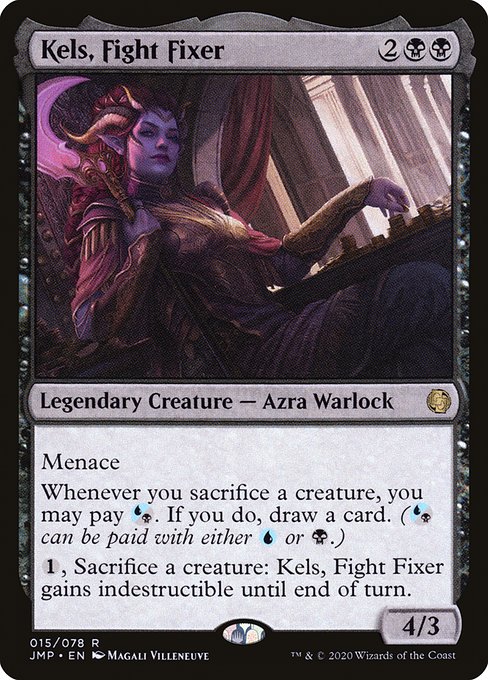
Image courtesy of Scryfall.com
Nostalgia, Sacrifice, and the Social Glue of Modern Magic
There’s something quietly magical about a card that arrives with a wink to the past while still feeling fresh on the battlefield. Kels, Fight Fixer embodies that tug between memory and momentum ⏳🔥. Released as part of Jumpstart, a set built to recreate the excitement of opening two-packs and pairing them into playful, unpredictable games, Kels isn’t just a niche pick for black-centered decks. It’s a reminder of why we first fell for MTG: the thrill of a clever line of play, the drama of a well-timed sacrifice, and the shared laughter when a plan comes together at the table 🎲. Nostalgia isn’t a solo emotion here—it’s a social arc, weaving players together as they navigate risk, reward, and a little bit of chaos.
A card with a bite and a clever bend
On the surface, Kels, Fight Fixer is a four-mana rare from Jumpstart with a simple, antagonistic aura: a legendary Azra Warlock who brings menace to the board and a toolkit that thrives on sacrifice. Its mana cost is 2}{B}{B and it carries a color identity of B/U, a nod to the hybrid, dual-path nature of many modern sac and spell-slinging archetypes. The text box delivers two key abilities that spark synergy rather than clutter:
- Whenever you sacrifice a creature, you may pay {U/B}. If you do, draw a card. (Note that {U/B} can be paid with either blue or black mana.)
- 1, Sacrifice a creature: Kels gains indestructible until end of turn.
That pairing is deliciously old-school in flavor but bright with modern nuance. The first ability invites a whirlwind of sac-outlet decisions—do you give up a creature to draw, feeding a deck built around tempo and card advantage? Do you push through a strategic draw step to refill your hand at a critical moment? The {U/B} payment bridge is a clever nod to hybrid mana’s flexibility, letting your deck lean blue, black, or a balance of both as the game state shifts 🔮💎. The second ability, a single-card durability boost, is a tempo tool that turns risky plays into potentially unstoppable final pushes. It’s a design that rewards planning, memory, and bold in-the-moment choices—a nostalgia-trip that still plays beautifully in today’s crowded formats ⚔️.
The nostalgia thread: Jumpstart’s social design and Kels’s role
Jumpstart arrived as a deliberate throwback to a more social era of MTG gaming. In its DNA is the idea of pairing two random booster-style experiences to spark immediate, casual, and often chaotic games. That spirit invites players to lean into shared stories rather than solitary power calculations. With Kels, that spirit is amplified: you’re not just casting a malice-infused minion; you’re choreographing a mini-drama around sacrifice, risk, and payoff. The art by Magali Villeneuve, the bold typography, and the set’s “legendary” framing all contribute to a sense of lore and theatre—an invitation to tell a story at the table as you click through turns 🧙♂️🎨. It’s the kind of card that invites you to recall your first forays into magic and your favorite moments of eye-catching saves, big swings, and “I can’t believe that worked” reactions.
“Sacrifice pays you back in stories as much as cards.”
From a gameplay perspective, Kels encourages a thoughtful, midrange-to-control posture that still leans aggressive when the moment is right. It rewards players who plan around sacrifice synergies—the classic engine of many black-centered strategies—while offering a neat, blue-tinted twist with the card-draw option. The indestructible line, usable after sacrificing a creature, is a lightbulb moment for players who love synergies with sacrifice outlets like Viscera Seer or Browbeat-era classics—tools that turn each sac event into a potential clutch moment. It’s a design that respects the tradition of sacrifice-based combos but keeps the door open for more casual play, where the table’s laughter is often as valuable as the win line 🧙♂️🔥.
Value, accessibility, and cultural resonance
In terms of collector culture, Kels sits in an approachable space. Its rarity is rare, and its price—roughly a few dimes in the current market—reflects Jumpstart’s broad accessibility. The card’s EDHREC rank sits lower on the list (around the mid-teens thousands), which aligns with its role as a flavorful ligne of play rather than a cornerstone of the modern metagame. Yet that’s precisely what helps it feel special: the nostalgia comes from personal memory and player-to-player connection, not merely a peak-tier circuit performance. For many players, the joy of Kels will be the sense of revisiting a familiar design language that still invites fresh, creative lines of play in today’s varied meta 🧙♂️🎲.
As a modern collector and player, you can appreciate how Jumpstart’s design philosophy nudges us toward shared experiences. The card’s mechanics encourage interaction with opponents—sacrificing a creature becomes a moment of negotiation, risk, and strategy—while the indestructible option adds a layer of resilience that keeps the conversation alive around the table. That collaborative tension is the nostalgic heartbeat that makes MTG resonate across generations: it’s not just the numbers, but the memories we build while weaving through a game where every decision echoes with stories of prior games and friends who sat across the table last weekend 🔥⚔️.
For those who want to explore this vibe beyond the game, consider keeping a few mobility-friendly accessories on hand to remind you of that social spark—like a sleek, protective case that travels with you to your next Friday night session. To help you stay connected while you dive back into the multiverse, check out the Slim Lexan Phone Case for iPhone 16—ultra-thin, glossy protection that travels as well as your deck does. Small details, big memories. 🧙♂️🎨